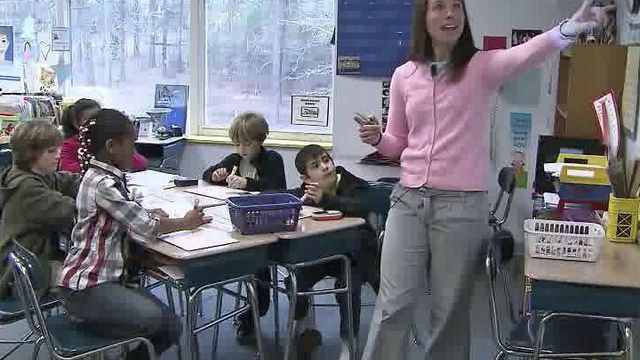Wake County schools see steady academic gains
Schools in Wake County made steady academic gains on 2011-12, according to data released by the state Department of Public Instruction Thursday.
Posted — UpdatedSchools in Wake County made steady academic improvements on end-of-year and end-of-course tests in 2011-12, according to performance-measure data released Thursday by the North Carolina Department of Public Instruction.
Students increased proficiency at every grade level and in every subject tested, except for seventh-grade math. Third-grade students showed the most improvement, gaining 2.4 percentage points in math and 2.2 percentage points in reading. Proficiency rates for Algebra I, biology and English end-of-course tests also increased.
The greatest gains, Wake schools Superintendent Tony Tata said, were with economically disadvantaged students.
"We grew at all ends of the spectrum – the middle, the top and the economically disadvantaged," he said. "It really tells us that our focus on differentiation and closing gaps is working."
Tata cited academic improvements at Raleigh's Barwell Elementary School, which was among the lowest-performing schools in the district two years ago. It saw proficiency gains of 9.7 percent, making it a high-performing school.
Millbrook Magnet Elementary, where 65 percent of students are economically disadvantaged, saw a 9.8 percentage point gain in proficiency.
In the past, federal funds were targeted to specific students at low-performing schools, but last year the school system made changes that allowed for more flexibility in how the funding was spent.
"We were able to hire two literacy coaches, which really did help us with our reading and writing instruction," Millbrook principal Paula Trantham said.
The school also increased math instruction and created an after-school program.
Tata credits the improvements to hard work by teachers, principals and other school staff.
"What it tells you is that whoever walks in the door of a school, those teachers are going to teach them," he said. "We're focused on student achievement."
In high schools, students demonstrated an overall proficiency rate of 85.8 percent, an increase of 2.5 percent points from last year.
Elementary school students also recorded impressive gains, jumping from 80.2 percent to 82.1 percent.
And middle school students were also proficient at an 82.1 percent rate, up. 0.9 percentage points from 2010-2011.
Tata said the numbers are positive, noting that the academic curriculum has become more rigorous.
"There's been no easing. What this is, is blood sweat and tears that you see. Hard work on behalf of teachers parents, students principals and staff," he said.
But there is room for improvement, he said. Seven percent of schools did not meet expected growth.
"We're going to take a hard look at them," he said. "We have a school-improvement plan process, and we're going to go back to the drawing board with those schools and make sure they make growth."
• Credits
Copyright 2024 by Capitol Broadcasting Company. All rights reserved. This material may not be published, broadcast, rewritten or redistributed.





